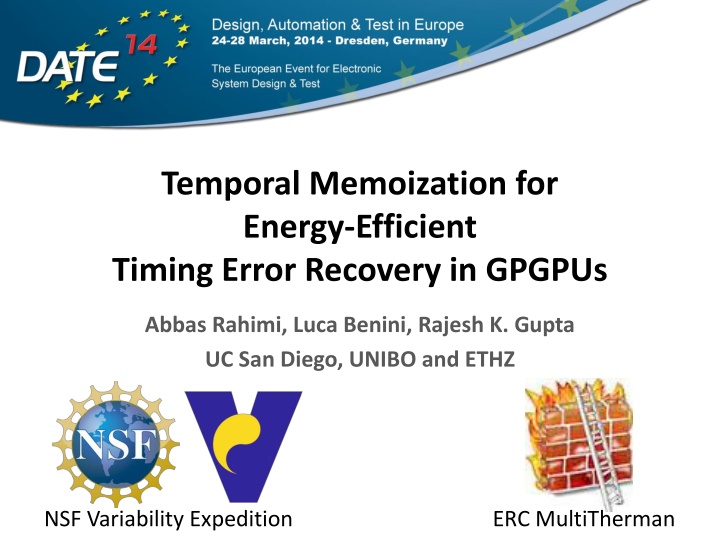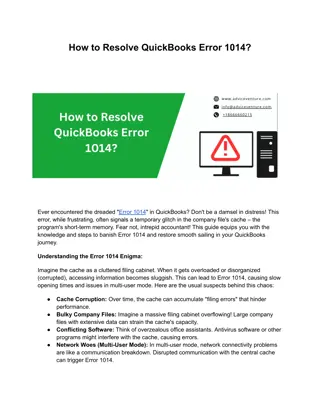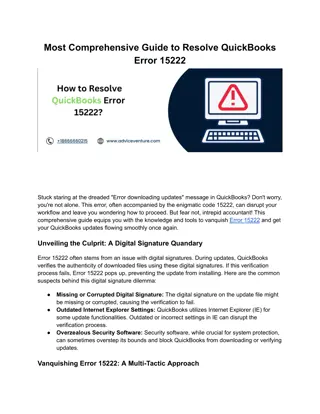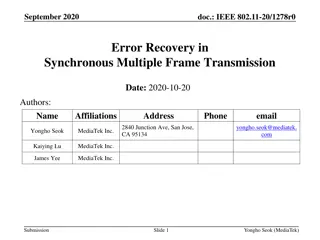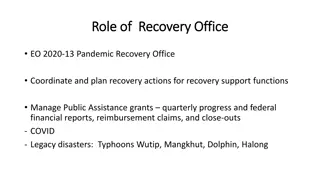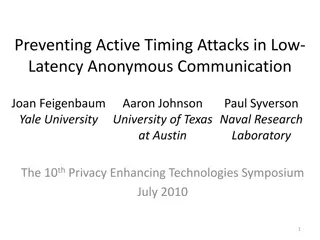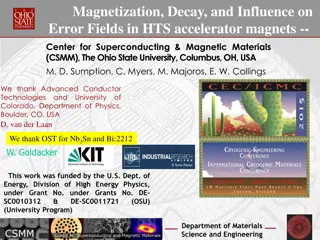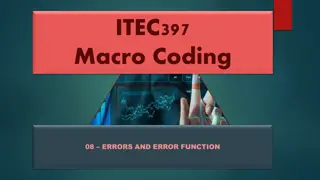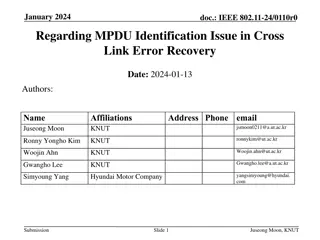Energy-Efficient Timing Error Recovery in GPGPUs
Addressing variability challenges in nanoscale CMOS, this research presents temporal memoization for energy-efficient timing error recovery in GPGPUs. The study explores sources of variability, costs of variability-tolerance, and temporal instruction reuse in GPGPUs. Experimental setup and results are discussed, along with conclusions and future work focusing on eliminating guardbands to reduce timing errors.
Download Presentation

Please find below an Image/Link to download the presentation.
The content on the website is provided AS IS for your information and personal use only. It may not be sold, licensed, or shared on other websites without obtaining consent from the author.If you encounter any issues during the download, it is possible that the publisher has removed the file from their server.
You are allowed to download the files provided on this website for personal or commercial use, subject to the condition that they are used lawfully. All files are the property of their respective owners.
The content on the website is provided AS IS for your information and personal use only. It may not be sold, licensed, or shared on other websites without obtaining consent from the author.
E N D
Presentation Transcript
Temporal Memoization for Energy-Efficient Timing Error Recovery in GPGPUs Abbas Rahimi, Luca Benini, Rajesh K. Gupta UC San Diego, UNIBO and ETHZ NSF Variability Expedition ERC MultiTherman
Outline Motivation Sources of variability Cost of variability-tolerance Related work Taxonomy of SIMD Variability-Tolerance Temporal memoization Temporal instruction reuse in GPGPUs Experimental setup and results Conclusions and future work 26-March-14 Luca Benini/ UNIBO and ETHZ 1
Sources of Variability Variability in transistor characteristics is a major challenge in nanoscale CMOS: Static variation: process (Leff, Vth) Dynamic variations: aging, temperature, voltage droops To handle variations Conservative guardbands loss of operational efficiency guardband actual circuit delay Clock Temperature Process Aging VCCdroop Slow Fast 26-March-14 Luca Benini/ UNIBO and ETHZ 2
Variability is about Cost and Scale Eliminating guardband Timing error Bowman et al, JSSC 09 Costly error recovery 26-March-14 Luca Benini/ UNIBO and ETHZ 3 3 Bowman et al, JSSC 11
Cost of Recovery is Higher in SIMD! Cost of recovery is exacerbated in SIMD pipelined: I. Vertically: Any error within any of the lanes will cause a global stall and recovery of the entire SIMD pipeline. II. Horizontally: Higher pipeline latency causes a higher cost of recovery through flushing and replaying. error rate wider width Recovery cycles increases linearly with pipeline length RF ALU M WB Wide lanes IF RF ALU M WB . quadratically expensive RF ALU M WB 4 Deep pipes
SIMD is the Heart of GPGPU Stream Core (SC) Compute Device Compute Unit (CU) Ultra-threaded Dispatcher Processing Elements (PEs) SIMD Fetch Unit Wavefront Scheduler Compute Unit (CU0) Compute Unit (CU19) Stream Core (SC15) Stream Core (SC0) Branch T X Y Z W L1 L1 Crossbar Local Data Storage General-purpose Reg Global Memory Hierarchy X : MOV R8.x, 0.0f Y : AND_INT T0.y, KC0[1].x Z : ASHR T0.x, KC1[3].x W:________ T:_________ VLIW Radeon HD 5870 (AMD Evergreen) 20 Compute Units (CUs) 16 Stream Cores (SCs) per CU (SIMD execution) 5 Processing Elements (PEs) per SC (VLIW execution) 4 Identical PEs (PEX, PEY, PEW, PEZ) 1 Special PET 26-March-14 Luca Benini/ UNIBO and ETHZ 5
Taxonomy of SIMD Variability-Tolerance Guardband No timing error Timing error Hierarchically focused guardbanding and uniform instruction assignment Error recovery Rahimi et al, DATE 13 Rahimi et al, DAC 13 Predict & prevent Decoupled recovery Lane decoupling through provate queues Pawlowski et al, ISSCC 12 Krimer et al, ISCA 12 Memoization Recalling recent context of error-free execution Rahimi et al, TCAS 13 26-March-14 Luca Benini/ UNIBO and ETHZ 6 6 Detect-then-correct
Related Work: Predict & Prevent Uniform VLIW assignment periodically distributes the stress of instructions among various slots resulting in a healthy code generation. Host CPU Dynamic Binary Optimizer Na ve Kernel Healthy Kernel GPGPU Rahimi et al, DAC 13 Tuning clock frequency through an online model-based rule in view of sensors, observation granularity, offline TER raw data Parametric Model PATV_config target_TER Classifier P (2-bit) A (3-bit) T (3-bit) V (3-bit) instruction Sensor online PATV P A T V tclk FUi LUTs FUj GPU FUk SIMD IF CLK control tclk(5-bit) 26-March-14 and reaction times. max Luca Benini/ UNIBO and ETHZ 7 Rahimi et al, DATE 13
Related Work: Detect-then-Correct Lane decoupling by private queues that prevent errors in any single lane from stalling all other lanes self-lane recovery RF ALU M WB D-Que. IF RF ALU M WB D-Que. . Pawlowski et al, ISSCC 12 Krimer et al, ISCA 12 RF ALU M WB D-Que. Causes slip between lanes mechanisms to ensure correct execution Lanes are required to resynchronize for a microbarrier (load, store) additional performance penalty 26-March-14 Luca Benini/ UNIBO and ETHZ 8
Taxonomy of SIMD Variability-Tolerance Guardband No timing error Timing error Hierarchically focused guardbanding and uniform instruction assignment Error ignorance Error recovery Predict & prevent Ensuring safety of error ignorance by fusing multiple data-parallel values into a single value Decoupled recovery Lane decoupling through provate queues Memoization Detect & ignore Recalling recent context of error-free execution Detect-then-correct: exactly or approximately through memoization Detect-then-correct 26-March-14 Luca Benini/ UNIBO and ETHZ 9 9
Memoization: in Time or Space Reduce the cost of recovery by memoization-based optimizations that exploit spatial or temporal parallelisms Temporal error correction Contexta[t-k] Contextb[t-k] Contextc[t-k] Contexta[t-1] Contextb[t-1] Contextc[t-1] Contexta[t] Contextb[t] Contextc[t] Spatial error correction Contextix Reuse HW Sensors [Spatial Memoization] A. Rahimi, L. Benini, R. K. Gupta, Spatial Memoization: Concurrent Instruction Reuse to Correct Timing Errors in SIMD, IEEE Tran. on CAS-II, 2013. 26-March-14 Luca Benini/ UNIBO and ETHZ 10
Contributions I. A temporal memoization technique for use in SIMD floating-point units (FPUs) in GPGPUs Recalls the context of error-free execution of an instruction on a FPU. Maintain the lock-step execution To enable scalable and independent recovery, a single- cycle lookup table (LUT) is tightly coupled to every FPU to maintain contexts of recent error-free executions. III. The LUT reuses these memorized contexts to exactly, or approximately, correct errant FP instructions based on application needs. II. 26-March-14 Luca Benini/ UNIBO and ETHZ 11
Concurrent/Temporal Inst. Reuse (C/TIR) Concurrent/Temporal Inst. Reuse (C/TIR) Parallel execution in SIMD provides an ability to reuse computation and reduce the cost of recovery by leveraging inherent value locality CIR: Whether an instruction can be reused spatially across various parallel lanes? TIR: Whether an instruction can be reused temporally for a lane itself? CIR RF ALU M WB IF RF ALU M WB . Utilizing memoization: 1) C/TIR memoizes the result of an error-free execution on an instance of data. 2) Reuses this memoized context if they meet a matching constraint (approximate or exact) RF TIR ALU M WB 26-March-14 Luca Benini/ UNIBO and ETHZ 12 12
FP Temporal Instruction Reuse (TIR) A private FIFO for every individual FPU I. Exact matching constraint; for Black-Scholes II. Approximate matching constraint (ignoring the less significant 12 bits of the fraction); for Sobel 5 26-March-14 Luca Benini/ UNIBO and ETHZ 13
Overall TIR Rate of Applications Programmable through memory-mapped registers Approximate matching Exact matching Mostly, hit rate increases < 10% when FIFO increases from 10 to 1,000 FIFOs with 4 entries provide an average hit rate of 76% (up to 97%) have 2.8 higher hit rate per power compared to the 10 entries 26-March-14 Luca Benini/ UNIBO and ETHZ 14
Temporal Memoization Module Execution stage of FPU Write stage Read stage replay recovery Error Control Unit (ECU) temporal memoization module (in gray) superposed on the baseline recovery with EDS+ECU (replay) error err1 err2 err3 err4 errorPipe OP1 Stage1 Stage2 Stage3 Stage4 QS 0 1 QPipe OP2 QL clk Hit LUT QL Masking vector QS Wen LUT Hit Error Action QPipe QS QS QL QL 0 0 LUT update QS QS QS QS QS Hit 0 1 Trigger ECU {OP1,OP2} {OP1,OP2} {OP1,OP2} {OP1,OP2} buffers OP1 1 0 LUT reuse + FP CLK gating OP2 clk Wen 1 1 LUT reuse + FP CLK gating + error masking QL Comp. Comp. Comp. Comp. 26-March-14 Masking vector Luca Benini/ UNIBO and ETHZ 15
Experimental Setup We focus on energy-hungry high-latency single-precision FP pipelines o Memory blocks are resilient by using tunable replica bits o The fetch and decode stages display a low criticality [Rahimi et al, DATE 12] o Six frequently exercised units: ADD, MUL, SQRT, RECIP, MULADD, FP2FIX; 4 cycles latency (except RECIP with 16 stages) generated by FloPoCo. Have been optimized for signoff frequency of 1GHz at (SS/0.81V/125 C), and then for power using high VTHcells in TSMC 45nm. 0.11% die area overhead for Radeon HD 5870. Multi2Sim, a cycle-accurate CPU-GPU simulator for AMD Evergreen The naive binaries of AMD APP SDK 2.5 26-March-14 Luca Benini/ UNIBO and ETHZ 16
Energy Saving for Various Error Rates error rate of 0%: on average 8% saving error rate of 1%: on average 14% saving error rate of 2%: on average 20% saving error rate of 3%: on average 24% saving error rate of 4%: on average 28% saving Temporal memoization module does NOT produce an erroneous result, as it has a positive slack of 14% of the clock period. Thanks to efficient memoization-based error recovery that does 26-March-14 not impose any latency penalty as opposed to the baseline Luca Benini/ UNIBO and ETHZ 17
Efficiency under Voltage Overscaling 8% saving @ nominal volt 66% saving 6% saving FPUs of the baseline are reduced their power as consequence of negligible error rate, while we cannot proportionally scale down the power of the temporal memoization modules. 26-March-14 Baseline faces an abrupt increasing in error rate therefore frequent recoveries! Luca Benini/ UNIBO and ETHZ 18
Conclusion A fast lightweight temporal memoization module to independently store recent error-free executions of a FPU. To efficiently reuse computations, the technique supports both exact and approximate error correction. Reduces the total energy by average savings of 8%- 28% depending on the timing error rate. Enhances robustness in the voltage overscaling regime and achieves relative average energy saving of 66% with 11% voltage overscaling. 26-March-14 Luca Benini/ UNIBO and ETHZ 19
Work in Progress To further reduce the cost of memoization, we replaced LUT with associative memristive (ReRAM) memory module that has a ternary content addressable memory [Rahimi et al, DAC 14] 39% reduction in average energy use by the kernels Collaborative compilation + Approximate storage 26-March-14 Luca Benini/ UNIBO and ETHZ 20
Grazie dellattenzione! NSF Variability Expedition ERC MultiTherman 26-March-14 Luca Benini/ UNIBO and ETHZ 21
